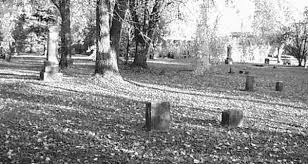Designated cemeteries
Learn how municipalities can designate a cemetery as a heritage property.
Introduction
Ontario cemeteries are a tangible link to ordinary individuals and famous people in our past. Many are an irreplaceable part of the province's cultural heritage.
Their landscapes, monuments and vegetation are part of our built environment, with their own unique history, development and growth.
The inscriptions on their monuments teach us about local, medical and material history, as well as geography, archaeology, genealogy and much more.
Designating a cemetery
Many municipalities are interested in recognizing and protecting cemeteries.
Municipal councils can designate a cemetery as a heritage property, either through:
- individual designation under Part IV of the Ontario Heritage Act
- Heritage Conservation Districts under Part V of the Ontario Heritage Act
Information in a designation
When developing a designation bylaw for council approval, the most important parts are:
- well-worded descriptions of the cemetery in the statement of cultural heritage value or interest
- well-worded descriptions of their built and landscape features in the description of heritage attributes
These descriptions are essential to provide a clear understanding of the heritage significance of these features.
Historical or associative significance
Where cemeteries are significant primarily for historical or associative reasons, a designation bylaw should include information such as historical association with:
- a specific event, such as a battle or a disaster
- well-known people, such as a pioneer founding family
- a well-known person in the burial place
- a well-known rural community and associated cemetery
Context and landscape design significance
Where context and landscape design are significant, a designation bylaw should describe the attributes of the landscape in which the cemetery is located, such as:
- design and layout of the cemetery, including special landscape features such as trees, plantings, fences, entrances, roads, open spaces, walls, pathways, gates, and fountains
- the relationship of the cemetery to its general community, historical settlement patterns or use of land
- a particular designer or landscape firm involved
- the integrity of the site
- whether the property is one of only a few remaining
- its role as a physical or spiritual landmark
Craftsmanship and architectural design significance
Where craftsmanship and architectural design are significant, the designation bylaw should describe the attributes of the built features on the property, such as:
- funerary monuments, fences, gates, markers and mausoleums
- the name of the builder, artist, designer, mason, carver or architect
- the building or marker type, including materials
Descriptions of the built features of the property, in particular of the buildings or markers should include:
- religious and artistic influences in pyramids, obelisks, metal work
- type or architectural or decorative elements, carving or detailing, such as lambs and angels
- special construction techniques or devices
Municipal heritage permits
The operation and management of cemeteries in Ontario falls under the Funeral, Burial and Cremation Services Act.
If a cemetery is also designated under the Ontario Heritage Act, most day-to-day activities, including new burials, would not require heritage permits from a municipality.
As with other kinds of designated properties, a permit would be required if a proposed activity or alteration would affect the heritage attributes outlined in the designation.
Example of a designated cemetery: Sault Ste. Marie Old Town Cemetery

The Sault Ste. Marie Old Town Cemetery was designated under bylaw 94-113, modified to reflect requirements of the Ontario Heritage Act, 2005.
Description of property
The Old Town Cemetery or Queen Street Cemetery, 1186 Queen Street East, is a small 19th century cemetery found on the north side of Queen Street, between Pine and Elizabeth Streets.
Statement of cultural heritage value or interest
The Old Town Cemetery is of cultural heritage value as the last remaining 19th century rural municipal cemetery in Sault Ste. Marie. In use between 1863 and 1914, the gravesites found in the cemetery provide important insight into the lives of Sault Ste. Marie's inhabitants and reflect the key historical themes in the development of the city during this period.
The Old Town Cemetery is also of value as a good example of 19th century rural municipal cemetery design in a Northern Ontario community. It is characterized by a naturalistic setting to attract and comfort the living, the creation of a secure space for the dead, the use of markers and monuments to perpetuate the memory of individuals of historic importance and a park-like layout for public use.
Description of heritage attributes
Key attributes of the cemetery that reflect its value as an important link to the history of Sault Ste. Marie include:
- its original markers and monuments, with their surviving inscriptions
- the variety of styles, materials and symbolism represented in the markers and monuments
- the range of size and sophistication of markers and monuments, from modest to elaborate
Key attributes of the cemetery that reflect its value as an example of 19th century rural municipal cemetery design in northern Ontario include:
- its location, orientation and dimensions
- its monuments, sculptures and structures
- its park-like setting, including its mature trees
- the original plan and placement of gravesites